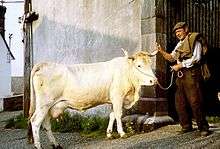Lourdaise
|
Cow at the Salon international de l'agriculture de Paris, 2013 | |
| Conservation status | FAO (2007): critical-maintained[1]:41 |
|---|---|
| Country of origin | France |
| Distribution | Midi-Pyrénées |
| Use | formerly triple-purpose, meat, milk and draught; now mainly meat |
| Traits | |
| Weight | |
| Height |
|
| Skin colour | white |
| Coat | white or creamy white[4]:233 |
| Horn status | lyre-shaped |
| |


The Lourdaise is an endangered French breed of domestic cattle. It is named for the town of Lourdes, in the Hautes-Pyrénées département of the region of Occitanie, and originated in the surrounding country, particularly in the cantons of Argelès, Bagnères-de-Bigorre and Ossun.[5] It was formerly a triple-purpose breed, kept for its milk, for its meat and for draught work. It was widely distributed in the Pyrénées of south-western France. It came close to extinction in the 1980s, but has since recovered following conservation efforts. It remains critically endangered.
History
The Lourdaise originated in the rural areas surrounding Lourdes, now in the Hautes-Pyrénées département of Occitanie. It was particularly associated with the cantons of Argelès, Bagnères-de-Bigorre and Ossun, but was widely distributed in the area. It was the principal cattle breed of the traditional regions of the Bigorre and of the Lavedan.[5] A herd-book was established in the 1890s, and in 1896 it held a total of 850 animals.[5] At the beginning of the twentieth century there were some 25 000 head;[4]:233 more than 200 bulls were approved for public use as sires.[5]
Breed numbers fell drastically in the years following the Second World War, for three reasons: the mechanisation of agriculture meant that there was decreased demand for draught cattle; specialised single-purpose breeds, such as the Braunvieh and Friesian for milk and the Charolaise and Limousine for beef, were introduced to the area; and in 1960, Edmond Quittet, the Inspecteur général de l'agriculture, established a policy of reduction of the number of French minority breeds. By 1983, only 30 Lourdaise cows remained.[5] Conservation efforts were begun, with contributions from the Parc National des Pyrénées, the French Ministry of Agriculture, and the regional administration of Haute-Pyrénées.[5]
The Lourdaise was listed as "critical-maintained" by the FAO in 2007.[1]:41 In 2014 the total population was reported to be 268.[6]
Characteristics
The Lourdaise is white or cream-coloured. The skin is white and the muzzle and mucous areas are pale.[3] The inner side of the thigh and the surround of the eyes and of the muzzle is white.[5]
Use
The Lourdaise was formerly a triple-purpose breed, kept for its milk, for its meat and for draught work. Milk production is estimated at 3000 l in a lactation of 305 days; fat content is about 3.8% and protein about 3.3%.[2]:241 There is enough milk for naturally-fed milk veal production.[5]
References
- 1 2 Barbara Rischkowsky, D. Pilling (eds.) (2007). List of breeds documented in the Global Databank for Animal Genetic Resources, annex to The State of the World's Animal Genetic Resources for Food and Agriculture. Rome: Food and Agriculture Organization of the United Nations. ISBN 9789251057629. Accessed November 2016.
- 1 2 Marie Dervillé, Stéphane Patin, Laurent Avon (2009). Races bovines de France: origine, standard, sélection (in French). Paris: Éditions France Agricole. ISBN 9782855571515.
- 1 2 3 Étude de la race bovine: Lourdaise (in French). Bureau des Ressources Génétiques. Archived 29 August 2003.
- 1 2 Valerie Porter, Lawrence Alderson, Stephen J.G. Hall, D. Phillip Sponenberg (2016). Mason's World Encyclopedia of Livestock Breeds and Breeding (sixth edition). Wallingford: CABI. ISBN 9781780647944.
- 1 2 3 4 5 6 7 8 La vache Lourdaise (in French). Conservatoire du Patrimoine Biologique Régional de Languedoc-Roussillon-Midi-Pyrénées. Archived 28 September 2008.
- ↑ Breed data sheet: Lourdaise/France. Domestic Animal Diversity Information System of the Food and Agriculture Organization of the United Nations. Accessed November 2016.